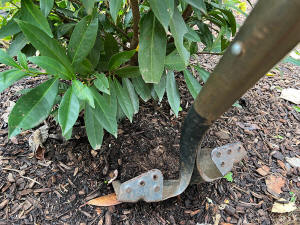Transplanting shrubs: Timing and technique for a thriving garden
[October 22, 2025]
By JESSICA DAMIANO
Itís the end of the gardening season, and those of us whoíve endured a
less-than-perfect layout may be itching to move shrubs around. But
proper timing is imperative.
I inadvertently planted a Clethra bush too close to a peach tree, and
their intertwining branches have been taunting me all summer. But
because the Clethra is a late-season bloomer, Iíll have to wait a bit
longer before I can safely move it.
As a general rule, shrubs (and perennials) that bloom in late summer and
fall should be transplanted in spring, just after they emerge from
dormancy. This timing provides ample time for roots to establish before
the plantís energy is redirected toward blooming.
Spring and early summer bloomers should be relocated in the fall, when
their blossoms and, sometimes, foliage, are long gone.
Start with roots
Before attempting to dig up shrubs, research how deep and wide their
roots typically grow. Shallow-rooted shrubs, like rhododendron, for
instance, are easier to dig up than, say, manzanita, which have very
deep root systems. Take the plantís age into account, too, as mature
shrubs will have larger roots than younger ones.
Your findings will guide your digging: New holes should be as close to
twice the width of roots as possible -- and exactly as deep.
Always dig a hole for the plantís new home before removing it from the
ground to minimize root exposure.
When possible, gently tie the plantís branches together to get a better
view of the area youíre digging. This step also helps prevent eye
injuries from errant stems.
Take care to dig up as much of the roots as possible, plunging a
sharp-edged shovel into the soil at what you estimate to be the rootsí
farthest point and working your way around the perimeter of the plant.
Then, retrace your steps, this time with more force to insert the tool
deeply enough to lift roots out of the ground from underneath.

[to top of second column]
|

This Oct. 14, 2025, image provided by Jessica Damiano shows a shovel
plunged into soil around a cherry laurel shrub. Gardeners can
transplant spring- and early summer-blooming plants like cherry
laurel in fall but should wait until spring to relocate late-summer
and fall bloomers. (Jessica Damiano via AP)
 Tips on planting
To avoid losing soil and damaging roots ó as well as your back ó
place the entire shrub onto a tarp and drag the tarp to the new hole
youíve prepared.
Carefully slide the rootball into the hole and assess its depth. If
necessary, remove the plant from the hole to add or remove soil as
needed to ensure the point where its roots meet the trunk óthe
plantís crown ósits at the same level it was previously.
Plant too deeply, and the crown and trunk will eventually rot; too
shallow, and the roots will dry out, suffer sun and cold damage, and
struggle to spread horizontally.
When youíre satisfied the shrub is sitting straight and at the
correct depth, begin backfilling the hole with soil, stopping
periodically to firmly tamp it down to eliminate air pockets. Water
the soil halfway through, then resume backfilling and tamping. Water
the soil again, then apply mulch over the entire root zone to retain
soil moisture, regulate soil temperature and repel weeds.
Water the plant regularly through frost during the entire first year
in its new home, but donít fertilize yet.
Apply a slow-release, low-nitrogen fertilizer in mid-to-late spring.
Doing so earlier would force the plant to allocate its limited
energy to growth rather than recovery and root development.
Allowing transplants time to settle in can mean the difference
between a struggling shrub and one that thrives for years to come.
All contents © copyright 2025 Associated Press. All rights reserved |